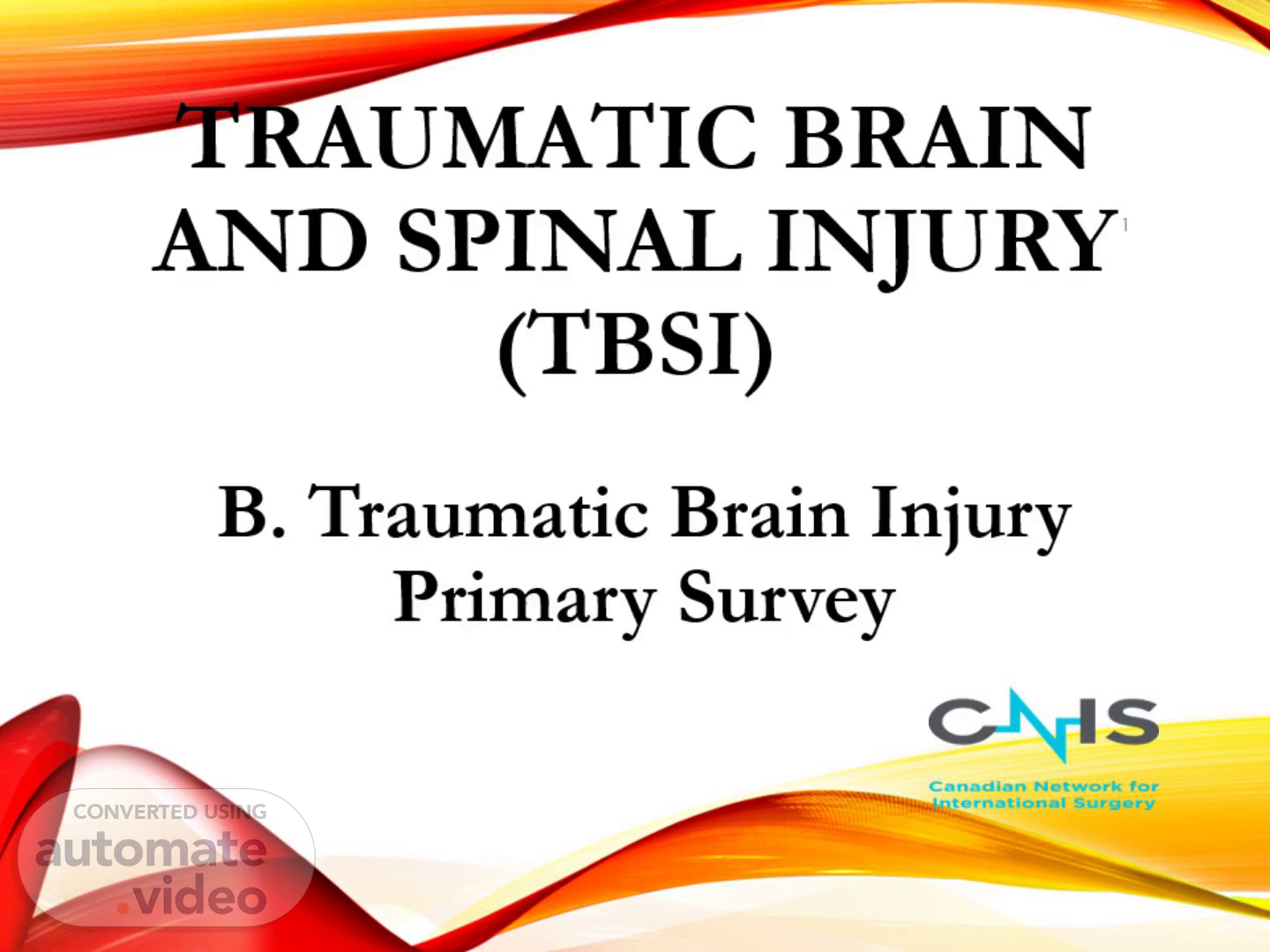
Page 1 (0s)
[Audio] We will now proceed with the management of Traumatic Brain Injury; TBI is managed within the ATLS Initial assessment, starting with the primary survey. The initial assessment and primary survey are the most important parts of the management of TBI. If this is not done well, CT scans and craniotomy will not be relevant..
Page 2 (22s)
[Audio] This study is from Uganda The intent, age gender, causes and distribution between unintentional and Intentional is similar throughout Eastern Africa..
Page 3 (1m 3s)
[Audio] Monitoring alternations in consciousness, cognition, and neurological signs is mandatory. TBI mortality doubles when it is associated with hypoxia or hypotension. Timely airway and ventilation management is critical to prevent hypoxia-related complications. Shock management, fluid resuscitation, and hemorrhage control are essential to improve outcomes. . Ensuring a patent airway, adequate oxygenation, and hemodynamic stability are foundational to TBI patients' care. Continuous monitoring and assessment to detect evolving symptoms or complications is required..
Page 4 (1m 44s)
[Audio] The initial management of the trauma patient starts with the Primary Survey. Airway, breathing and circulation are critical. Life-threatening conditions must be promptly identified and addressed..
Page 5 (2m 9s)
[Audio] The airway must be patent, and oxygen must be provided. Oxygen concentrators can be considered. The TBI and airway compromise both can cause altered mental status..
Page 6 (2m 23s)
[Audio] If a head-injured patient has a compromised airway due to factors such as facial fractures, swelling, or bleeding that obstructs the airway, early intubation may be necessary. Patients with head injuries may experience impaired ventilation, which can result from altered mental status, as neurological deficits affecting respiratory drive and chest trauma can impair ventilation. . Intubation may be required to support and maintain adequate oxygenation and ventilation. In patients with a Glasgow Coma Scale (GCS) score of less than eight or an AVPU of P or U. (indicating severe impairment of consciousness), intubation is often necessary to protect the airway and ensure proper oxygenation and ventilation..
Page 7 (3m 12s)
[Audio] Intubation helps protect the airway from aspiration of gastric contents or blood.. Mechanical ventilation allows control of oxygenation and ventilation, Intubation and controlled ventilation can help manage ICP by maintaining stable arterial carbon dioxide levels ensuring that the patient receives the necessary oxygen and expels carbon dioxide is crucial for preventing secondary brain injury. .Intubation can provide a controlled environment for frequent neurological assessment..
Page 8 (3m 45s)
[Audio] TBI impairs a patient's ability to maintain their airway, leading to airway compromise and respiratory distress .The respiratory control center in the brain stem are impacted indirectly through raised intracranial pressure (ICP).
Page 9 (4m 4s)
[Audio] Monitoring blood pressure and pulse can help identify signs of shock Hypotension must be urgently rectified. A pulse oximeter is very helpful.
Page 10 (4m 16s)
[Audio] Maintaining appropriate fluid balance is crucial in managing head-injured patients to optimize cerebral perfusion and reduce the risk of complications related to in Intracranial pressure. . Shock can result from hemorrhage, fractures, or concurrent injuries Normal Blood pressure maintains adequate cerebral perfusion and avoids excessive intracranial pressure. Ringers lactate or saline solutions are isotonic and do not cause shifts of fluid into or out of brain tissue Dextrose solutions can cause cerebral edema and worsen intracranial pressure\ Hypoglycemia must be treated, but It is essential to avoid hyperglycemia as it may exacerbate brain injury..
Page 11 (5m 2s)
[Audio] The AVPU disability assessment helps triage TBI patients for further evaluation and intervention, such as neuroimaging. Front-line health workers should use AVPU in the primary survey, while GCS in the secondary survey. pupil size and reactivity are important assessments which accompany GCS or AVPU.
Page 12 (5m 24s)
[Audio] AVPU is a quick and useful tool for initial assessment, especially in situations where time is of the essence, such as during emergency care or triage in trauma scenarios. It should be taught to frontline health workers..
Page 13 (5m 58s)
[Audio] Exposure must be done while maintaining patient privacy and dignity Maintain body temperature: prevent hypothermia or hyperthermia Use blankets or clothing as necessary Remove hazards in the patient's environment . NOTE:. bruising, bleeding, rashes, or other abnormalities, which may be signs of serious underlying injury..
Page 14 (6m 23s)
[Audio] Nest is a head-to-toe exam and AMPLE history. But if the patient deteriorates at any time, you must return to the primary survey, reevaluate ABCDE, and respond to any deterioration promptly..